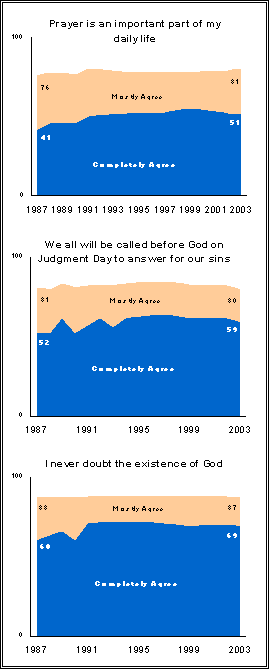
America remains an intensely religious nation and, if anything, the trend since the late 1980s has been toward stronger religious belief. Eight-in-ten Americans (81%) say that prayer is an important part of their daily lives, and just as many believe there will be a Judgment Day when people will be called before God to answer for their sins. Even more people (87%) agree with the statement “I never doubt the existence of God.”
Clearly, views on these three statements are highly related, and when these three questions are combined into a single indicator of religious intensity, fully 71% agree with all three statements, while just 7% disagree with all three. Both of these figures are slightly higher than was the case 16 years ago, when 68% agreed with all three statements, and 5% disagreed with them all. With more people at each end of the spectrum, somewhat fewer Americans express mixed views about their religious beliefs today (22%) than was the case in the late 1980s (27%).
While attitudes toward prayer and faith have remained very stable over that period, the number expressing strong agreement has increased slightly over the past decade-and-a-half. Today, 51% completely agree that prayer is important in their lives, up from 41% in 1987. And the percentage who completely agree that they never doubt God’s existence has risen from 60% to 69% over the same period.
Growing religious intensity also is seen in how Americans, especially self-described Protestants, characterize their religious faith. In the late 1980s, 41% of Protestants and 24% of the population overall identified themselves as “born- again or evangelical” Christians. Today, 54% of Protestants describe themselves this way, and evangelical Protestants make up the largest single religious category (30% of the population). This shift has been particularly stark among African Americans. Fifteen years ago, 36% of African Americans and 23% of whites and described themselves as born again or evangelical Protestants. Today, fully 50% of African Americans give this description, compared with 28% of whites.

While the way Protestants define their faith has changed, the broader religious landscape looks much as it did in the late 1980s. Most Americans (56%) continue to identify themselves as members of a Protestant faith, with a quarter saying they are Catholic. Fewer than one-in-ten (9%) say they have no religion, virtually unchanged from 15 years ago. Judaism, Church of Jesus Christ of Latter-day Saints, Orthodox Christianity, Islam, and other religions remain much smaller denominations.
This aggregate stability masks some relevant and important changes within subgroups of the population. For example, 56% of Hispanic Americans identify themselves as Catholic today, down from 68% fifteen years ago. And the percentage of younger Americans (those under age 30) who identify themselves as Protestants has fallen from 52% to 45% over this same time period. The number of young people who say they have no religion has increased slightly (from 12% to 16%).
This slight shift away from a denominational identification among younger Americans does not necessarily mean they are becoming less religious and more secular, however. Americans under age 30 are just as likely to report regular church attendance today as fifteen years ago, and strong religious faith is at least as widespread among younger Americans today as it was in the late 1980s: 63% of young people agree with all three religious statements about prayer, God, and a Judgment Day, which is virtually unchanged from 1987-1988 (61%).
Moreover, younger generations are becoming much more religious as they age. Fifteen years ago, 61% of people in their late teens and twenties agreed with all three religious statements. Today, 71% of people in these generations now in their thirties and forties express this level of strong religious faith. Over the same period, the percentage of Protestants in this age group identifying themselves as born again or evangelical has risen from 41% in the late 1980s to 55% now. As a result of these gains, people in their 30s and 40s today are considerably more religious than their 30-to-49-year-old counterparts were in the late 1980s.
There also is a small but growing minority of younger people who express more secular views. In 1987 and 1998, just 5% of the public disagreed with all three religious statements, and there was no difference between those under age 30 and older Americans. Today, 12% of young people reject all three items twice as many as among those age 30 and older (6%).
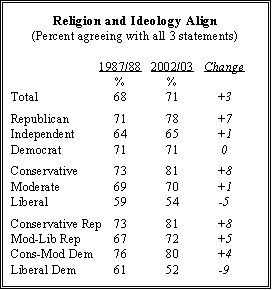
Religion, Ideology Increasingly Connected
Over the past 15 years, religion and religious faith also have become more strongly aligned with partisan and ideological identification. Republicans and Democrats were equally likely to express strong personal religious attitudes in 1987 and 1988; the same percentage in both parties affirmed the importance of prayer, belief in Judgment Day and strong belief in God (71% in each). But over the past 15 years, Republicans have become increasingly united in these beliefs, opening up a seven-point gap between the parties (78% vs. 71% of Democrats).
This growing divide is even more evident in looking at the relationship between political ideology and religious faith. While there has always been a correlation between conservatism and religiosity, the relationship has grown notably stronger in the past 15 years.

Religious commitment has increased substantially among self-identified conservatives (81% agree with all three statements on faith and belief, compared with 73% in 1987-88). Liberals, on the other hand, have become somewhat less religiously oriented. Just over half of self-identified liberals (54%) agree with all three religious statements, down from 59% fifteen years ago.
This religious/political alignment can also be seen within religious denominations. In 1987 and 1988, white evangelical Protestants were split fairly evenly along partisan lines (34% Republicans, 31% Democrats). Today, there is a nearly two-to-one Republican advantage among white evangelicals (43%-22%). The partisanship of non-evangelical white Protestants and black Protestants, by comparison, has been relatively stable.
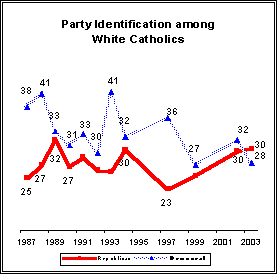
In addition, white Catholics, once strongly Democratic, are now much more politically divided. In the late 1980s, a significantly greater percentage of white Catholics identified themselves as Democrats than Republicans (41% vs. 24%). Today, partisan identification among white Catholics is divided almost evenly (31% Democrat, 29% Republican).
And again, this shift is driven predominantly by more highly religious Catholics. Among white Catholics who attend Mass regularly an 18-point Democratic identification advantage in the late 1980s (42% Democrat, 24% Republican) has turned into a dead-heat today (30% Democrat, 32% Republican). (See table on page 4.)
Social Issues: Tradition and Tolerance
Over the past 16 years, public values on most social issues have remained generally stable. Eight-in-ten say they have “old-fashioned values about family and marriage, ” and nearly as many (77%) agree that there are clear and immutable guidelines about good and evil.

The number who completely agree with these sentiments about four-in-ten in each case has shown only modest fluctuations over the past decade and a half.
Yet in that period there also has been a distinct shift toward acceptance of several social changes, some of which challenge traditional views of the family. There has been a broad increase in at least limited tolerance of homosexuality the number who believe that schools should not be allowed to fire homosexual teachers has risen from 42% in 1987 to 62% in the current survey.
Nearly as striking is the growing societal acceptance of interracial dating (see Part Five, pp.45-50). And there has been a more modest decline in the percentage who favor women returning to their “traditional roles in society” (from 30% in 1987 to 24% now).

Consequently, an increasing number of Americans are able to accept such social changes as homosexuality and changing women’s roles while maintaining traditional religious and social values.
Religion and Homosexuality Large Gaps Persist
The decline in anti-homosexual attitudes has occurred at roughly the same rate among traditionally conservative white evangelical Protestants as among more liberal religious groups and seculars. While large religious gaps remain two-thirds of white Catholics and mainline Protestants (68% each) oppose firing teachers on the basis of sexuality, compared with only 40% of white evangelical Protestants these gaps have neither grown nor shrunk as public attitudes have changed over time.
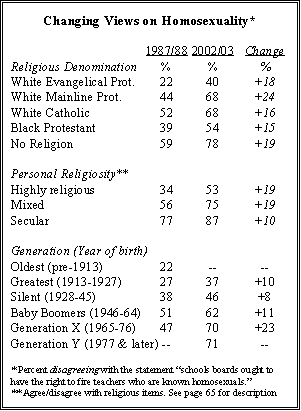
A similar pattern is evident in changing public attitudes on whether AIDS might be God’s punishment for immoral sexual behavior. A generation ago, the public was closely divided on this issue: in 1987, 43% felt AIDS was a punishment from God while 47% disagreed. Now by nearly three-to-one (70%-24%), Americans reject that idea.
White evangelical Protestants (42%) and black Protestants (36%) are more likely to feel that AIDS is God’s punishment than are white mainline Protestants (20%), white Catholics (18%) and the non-religious (14%). Still, moralistic interpretations of the AIDS disease have dropped among all groups about equally.
As with attitudes about race, views on homosexuality have a strong generational component, with younger generations much less negative toward gays. However, the overall increase in tolerance toward homosexuality is not merely a result of generational replacement younger, tolerant generations replacing older, less tolerant ones. There also has been a significant change of attitude within generations over time, suggesting that people’s views on this issue have shifted.
Little Change on Other Social Issues
These changes are even more notable because of the stability in the public’s values on other social issues. Half of Americans support the idea that books containing dangerous ideas should be banned from public school libraries, but there has been no change in this view between 1987 and now. A slight majority (52% currently) rejects the idea that pornography is harmless entertainment, and this view has also remained steady. And by roughly three-to one (72% to 23% currently) more agree than disagree that too many children are being raised in day care centers these days.
Abortion Views Stable over Past Decade
Most Americans (57%) say they oppose changing the laws to make it more difficult for a woman to get an abortion, while 36% are in favor, and there have been only slight changes in public opinion on this question over the past sixteen years. While abortion is a significantly more divisive issue today than was the case in 1987, most of the partisan and religious divisions were firmly in place a decade ago, and have changed little since.
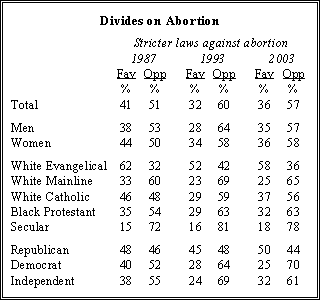
Partisan divisions over abortion became much more prominent in the early 1990s, and remain substantial today. In 1987, Democrats were only slightly less likely to favor stricter abortion laws (40%) than were Republicans (48%). Today, Republicans are twice as likely as Democrats (50% to 25%) to favor stricter abortion regulation. And religion remains a major dividing line in views on this issue, with most white evangelical Protestants supporting laws that would make it more difficult for a woman to have an abortion, and most white mainline Protestants opposed to such changes. White Catholics, split evenly over this issue in 1987, are now more likely to oppose (56%) than favor (37%) stricter abortion laws.
A small gender gap over the abortion issue in 1987 has gradually disappeared, as support for stricter abortion laws among women has fallen by eight points (women used to be somewhat more conservative than men on this issue.) The change among women has occurred primarily among older groups. Sixteen years ago fully half of women age 50 and older favored stricter limits on abortion, today just 35% in this age group say the same.
On highly charged issues related to reproduction and research, the public expresses ambivalence. On the one hand, a large majority 72% favors protecting the rights of the unborn in almost all cases. Yet, at the same time, 58% say they are more concerned about finding cures for diseases than about protecting embryos. Taken together, nearly one-in-four Americans (38%) say they believe in protecting the unborn but at the same time prioritize disease research over protecting human embryos. Smaller proportions take a consistently conservative (27%) or consistently liberal (19%) position on both questions.
Liberal Democrats are the only major demographic or political group where a majority does not agree with protecting the rights of the unborn in almost all cases (only 44%). Among religious groups, nine-in-ten white evangelical Protestants (91%), 61% of non-evangelicals, and 74% of white Catholics hold this opinion, compared with 53% of seculars. Among white Catholics, church attendance is a very important factor, with 83% of Catholics who attend church at least monthly favoring the rights of the unborn, compared with 62% of those who attend less often.